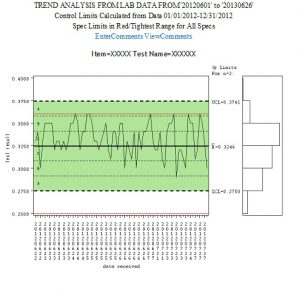In the first two posts in this series, Seeing the Light: How SMBs are Using Data and Insights to Get Ahead, I shared the motivations that prompted three SMBs to replace spreadsheets and intuition with a more sophisticated, analytics-driven approach to run their businesses.
In the second, I discussed the factors that decision-makers in these three companies viewed as make or break considerations in the analytics selection process.
In this third and final post, I look at how these SMBs are putting the SAS analytics solutions that they selected to work for their businesses, and the results that they're getting.
An Early Warning System to Prevent Issues from Becoming Problems

BGF Industries had millions of lab testing records, but lacked an effective way to extract insights from them to improve quality control. BGF wanted a system that could sort through this data, generate control charts, and proactively flag potential quality issues. The company also wanted a knowledge repository to make key findings readily available in case an issue came up again.
Working with SAS partner Lucid Analytics, BGF implemented SAS Business Intelligence for Midsize Business, giving BGF the "early warning system" it needs to constantly monitor production processes. "Every night this system pours through millions of lab testing records, generates control charts for each and every thing we test for, and creates a report that flags any charts where something may be out of control," explains Bobby Hull, Corporate Quality Assurance Manager at BGF.
According to Hull, “The flexibility of the SAS solution is like Legos. You can take a little piece of this and stick it to that and get what you need." This enabled Lucid Analytics to create a commentary field in the control charts for BGF to capture information about how to resolve quality issues. "Now we also have this guru repository so information can easily be passed on to different people," adds Hull.
When it comes to return on investment (ROI), Hull puts it this way: "People were asking me about ROI when we started the project. I told them that I couldn't quote them a dollar figure because how can you predict when you will avert a costly disaster? I couldn't predict that negative, but I could tell them that the investment would pay them back because it would help us spot trends, improve quality in our products and better serve our customers--all of which it has done." In addition, notes Hull, "It makes our auditor smile because the solution reflects our attitude toward quality and that helps enormously with ISO compliance."
Delivering What Customers Want

Oberweis Dairy needed to better understand customer buying behavior across its three distribution channels--home delivery, ice cream and dairy stores, and distribution partners. It wanted to get its flagship home delivery service growing again, increase revenue per transaction, improve customer retention, and increase market penetration across all of its channels.
"Very complicated spreadsheets, macros and pivot tables weren't providing the answers we needed," according to Bruce Bedford, VP of Marketing. "Now, we understand customers' buying behaviors like never before, and we can develop highly effective marketing campaigns across channels."
In dairy stores, Oberweis has improved transaction-level profitability by 1.2% due to the analytical approach it can take with its menu boards. As Bedford explains, "Now we can now figure out the best configurations. What foods to put on the menu, what goes best with what. We can test ideas like, what if we feature sundaes in a waffle bowl? We can present and test different options, see what customers want. This also cuts down on the time it takes for customers to make their selections, and the time it takes for us to serve them.
In addition, customer retention for Oberweis' home delivery service has soared by 36%--yielding over $640,000 of incremental revenue in just 6 months. "Our home delivery products are same price as in the store, but there's a delivery fee," Bedford notes. "We had been promoting free delivery by waiving our $2.99 weekly delivery fee for six months when customers signed up. But at the 6 month mark, we had a sharp drop in renewals. We figured it had to be tied to how we were structuring the promotion. We needed to decrease attrition, without lowering offer acceptance."
Oberweis used SAS Analytics to test and analyze different promotions, and learned that "when we offer new customers 99 cent delivery for one year, retention spikes up. Both promotions deliver $100 value to the customer, but the details significantly increased the retention rate, without reducing acceptance.'
The results have been so dramatic that Oberweis documented them in a paper that Bedford presented at the 2012 Midwest SAS User Group conference.
Improving Guest and Homeowner Experiences

Twiddy & Co. balances the need to maximize revenue for its individual homeowners with the concurrent need to provide truly exceptional vacation experiences to its guests. But, a myriad of complex spreadsheets were no longer up to the job. For instance, Twiddy needed to create daily reports quickly and provide them to staff to scan so that they could efficiently address any cleaning or safety issues prior to or immediately after guests' arrival. The company also wanted to provide vacation homeowners with the best possible value for needed property repairs and services. In addition, Twiddy wanted to optimize property bookings and pricing based on data instead of gut instinct.
Clark Twiddy, Director of Operations, recalls that when the company started to look for a solution, "It was a black hole. We didn't know if we would need to spend $250 or $100,000 but we knew we needed better analysis and decision support. Candidly, we wouldn't have spent $100,000, but we had to find a way innovate and improve. Our market here in North Carolina is very competitive with 14 smart companies in the same area. We joke that complacency is a great way for us to lose market share.”
According to Twiddy, SAS Analytics and Pinnacle, a SAS partner, helped them do just that. "It used to take 3 or 4 people hours a day to get information together into reports that became obsolete the following morning. Now we can get a report in seconds and see, for example, the median day-to-day cost for a certain type of repair, and compare costs for the 1100 different service providers we contract with--saving homeowners real money. We even have vendors asking us how they're doing on the SAS list and where they rank, so they can improve and get more business from us."
Twiddy estimates the solution has also cut error rates by about 20% per year. "More timely, accurate reports make it less likely that we'll send the wrong vendor to a home, or send a vendor to the wrong home, or that we'll flat-out miss something that needs to be fixed. Our housekeeping scores have increased, and repeat guests have gone from 47% to almost 60%," notes Twiddy.
Twiddy has also built a dynamic pricing model that he says "is an enormous help with building credibility and delivering results to homeowners. We’ve been able to deliver better bottom line results to homeowners, better vacation experiences to guests, smarter technology to staff, and sustain a high-end brand image in the mind of our customers.”
Perspective
If you've read all three of the posts in this series, you know that none of these companies just waved a magic wand and magically achieved successful outcomes from their analytics investments.
But, the good news is that none of these companies needed a magician--or an IT army--to help make this happen. Instead, they got there by:
- Facing the fact that their businesses would need to employ a more sophisticated approach to gather, create and use information to make the decisions in order to move ahead.
- Taking enough time upfront to assess what information they needed to make better decisions, what needs to happen to make this information actionable for the people who need to use it, and how they'll measure outcomes.
- Thoroughly evaluating internal capabilities, what they would need from an analytics solution and a solution provider, and getting the information they needed to select best-fit options for their companies.
So, mere mortal SMBs--take heart--and follow the guidance of these and other SMBs that are paving the way.
This is the final post in a three-part blog series by SMB Group sponsored by SAS that examines why and how SMBs are moving from spreadsheets and intuition to a data-driven approach to grow their businesses. This blog post is also available from SMB Group's website under Laurie's blogs.

1 Comment
Thanks a lot Laurie McCabe for posting such an informative blog on SMB's.